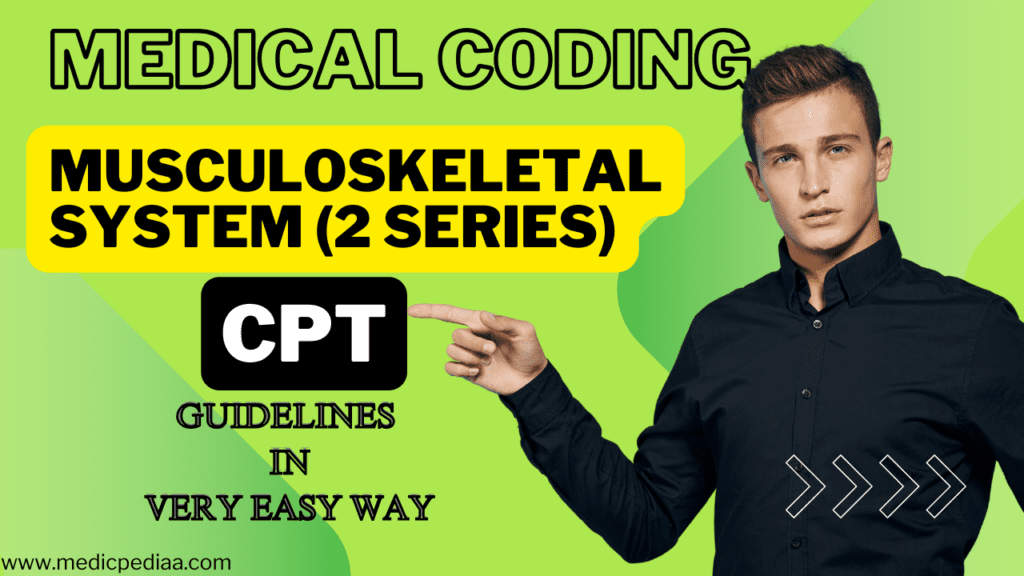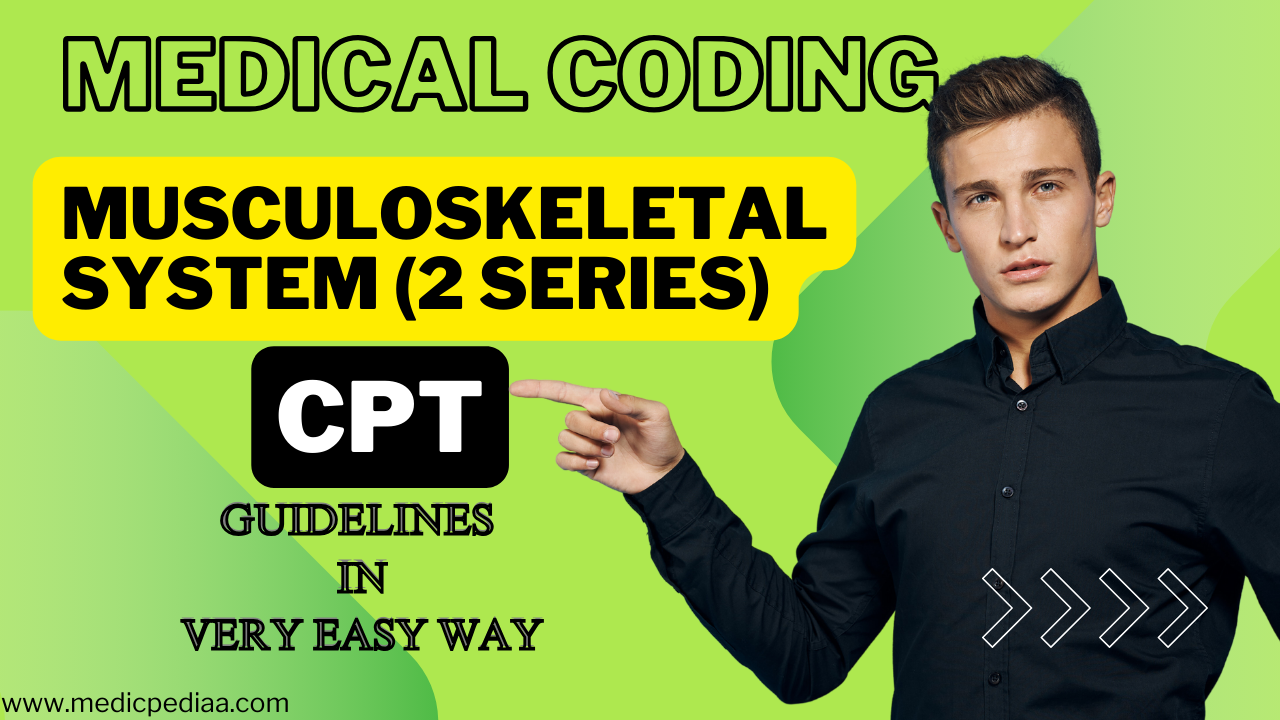Musculoskeletal System CPT Coding Guidelines 2024
Musculoskeletal System CPT Coding Guidelines 2024:-
Hello Reader , In this Article we explain all about Musculoskeletal System CPT Coding Guidelines 2024 in an easy way you can find codes and any updates related to Musculoskeletal cpt guidelines and the code range of musculoskeletal cpt guidelines is 20100-29999, and also you get modifier details that are used during the coding of musculoskeletal system cpt coding . Musculoskeletal cpt code range start from 20100 and end with 29999. There are two modifiers used in musculoskeletal CPT guidelines, which are explained in this article in a very easy way with appropriate examples.

Introduction of Musculoskeletal system:
The musculoskeletal system (locomotor system) is a human body system that provides our body with movement, stability, shape, and support.
Components of Muscular System
- Muscular system: skeletal muscles and tendons
- Skeletal system: bones, joints; associated tissues (cartilage, ligaments, joint capsule, bursae)
Coding Guidelines of Musculoskeletal System:
In Musculoskeletal procedures, local anesthesia is included so don’t code it separately.
Wound exploration (20100-20103):
- Do not report repair and debridement with code range (20100-20103).
- If laparotomy and thoracotomy performed with wound exploration then don’t code 20100-20103. Because it is included in laparotomy and thoracotomy.
- Identify anatomical site i.e neck, chest, abdomen, flank, back or extremity.
- If simple/ intermediate/ complex repair performed doesn’t require wound enlargement.
Excision in musculoskeletal (20150)
Excision of subcutaneous soft tissue tumors.
Excision of fascial or sub fascial soft tissue tumors.
Radicle resection of soft tissue tumors.
Radicle resection of bone tumors
How to pick a code Step Wise :
- Location and size of tumors
- Size is measuring the greatest diameter with narrow margin required.
- If complex repair is done to close the wound code separately.
Biopsy (20200-20251) :-
Examination of tissue taken from living body.
Guidelines of Biopsy in Musculoskeletal system :-
- Anatomical site
- Procedure (open/closed)
- Excision+ biopsy = excision
Introduction of removal ( 20500-20705) :-
Injection to sinus tract, tendon, trigger point, joints.
Arthrocentesis :-
Removal of fluid from joint
Physician inserts a needle through the skin and into a joint, bursa, or ganglion cyst. A fluid sample may be removed from the joint or a fluid may be injected for lavage or drug therapy.
Arthrocentesis Guidelines :-
- Codes based on size of joint.
- Ultrasound guidance is used or not.
- If procedure are performed more than one joint code separately.
Trigger point injections (20552-20553)
For injection codes related to triggered points (single or multiple), check for number of muscles given in the scenario, depend on that code 20552 (1-2 muscles) and 20553 (3 more than than 3 muscles).
Replantation Guidelines (20802 – 20838) :-
- Code anatomical site with complete amputation.
- If incomplete amputation, then add modifier 52 with CPT code.
- Incomplete procedure
Modifier 52 (reduce services) : –
Append modifier 52 to a procedure to show that the physician didn’t perform the complete procedure in the code descriptor.
Modifier use in Musculoskeletal system:
FA Left hand, thumb
F1 Left hand, second digit
F2 Left hand , third digit
F3 Left hand, fourth digit
F4 Left hand, fifth digit
F5 Right hand,thumb
F6 Right hand,second digit
F7 Right hand, third digit
F8 Right hand, fourth digit
F9 Right hand, fifth digit
TA left foot, great toe
T1 left foot, second digit
T2 left foot, third digit
T3 left foot, fourth digit
T4 left foot, fifth digit
T5 Right foot, great toe
T6 Right foot, second digit
T7 Right foot, third digit
T8 Right foot, fourth digit
T9 Right foot, fifth digit
Arthrodesis : Fusion or immobilzation of joints.
Spine Arthrodesis – fusion between vertebras
Spine Arthrodesis key term:
Look for location and approach
Bone graft
Instrumentation
Look for approach : lateral , anterior, posterior, and spinal deformity.
Bone graft – bone graft/ bone graft substitute is needed to create the environment for the solid bridge to form. It allows the new bone formation to fuse the section of the spine together.
After seeing the approach then we will check which type of bone graft like allograft, autograft , morselized ( machine Graft, chips form, powder form) and structure (original form).
Note: Don’t use modifier 51 and 62 with bone grafting.
Instrumentation : Hardware implants used in spine surgery.
Device include: Rods, hooks, plates, interbody cage.
If instrumentation is given in senerio then check which type of instrumentation like segmental, non segmental and anterior vs posterior.
There are two types of spinal instrumentation procedures:
- Segmental – stabilize the spine by attaching to each individual segment that was fused.
- Non- segmental: Doesn’t attach at each level curved rod is attached at top and bottom.
Note: Don’t use modifier 51 and 62 with instrumentation .
Do not use modifier with add on code in arthrodesis topic questions.
Fracture and/or dislocation : –
Look for open vs closed vs percutaneous fracture treatment .
Percutaneous fracture treatment:
Skeletal traction – Application of force to a limb segment via pin attached to the bone
Skin traction – Application of force using strapping applied directly to the skin.
External fixation :-
Re reduction of a fracture/ dislocation by the same physician would be identified by adding modifier 76.
Removal of external devices in the post operative period is included with an application of external immobilzation devices (cast, strapping and splint).
Removal of a superficial or deep implant (pin/ rod/buried wire) requires or surgical procedure to remove the implant would be billed with appropriate code.
If another procedure is necessary to do in the same site during the removal of implant can’t be code separately.
Open treatment : internal fixation, open reduction internal fixation (ORIF), intramedullary rods , open reduction.
Note: If closed fracture treatment procedure fails to be followed by an open procedure at the same session, code only the open procedure.
Closed Treatment : No fixation, with or without manipulation, cast application only , closed reduction, stablise , reduced, use of anesthesia, aligned .
Don’t code cast/splint separately with fracture repair.
Cast and strapping:
- Billed only under the circumstances like:
- If the physician treats the fracture or dislocation only with cast or splint without a restorative treatment of procedure to stabilize fracture/ dislocation.
- Don’t code cast for major procedure because it already included in it .
- Code cast for minor procedure.
Splints type: Two types of splint
- Dynamic splint – allow movements with stability.
- Static splint – prevent movement
Splints Guidelines :
- Identify type of splint whether short arm, long arm or finger splint.
- Identify whether static or dynamic splint.
————————————————————————————————————
For Medical Coding : https://medicopediaa.com/list-of-modifiers-used-in-cpt/
CPT Guidelines Anesthsia : https://medicopediaa.com/anesthesia-cpt-guidelines/
CPT Guidelines Integumentary :https://medicopediaa.com/integumentary-system-cpt-guidelines-2024/
In this Article We Cover important guidelines of cpt 2 series musculoskeletal system.
Musculoskeletal System CPT Guidelines 2024
For Any Questions Related to Medical Coding :
DM me on Insta : @medico_pediaa
